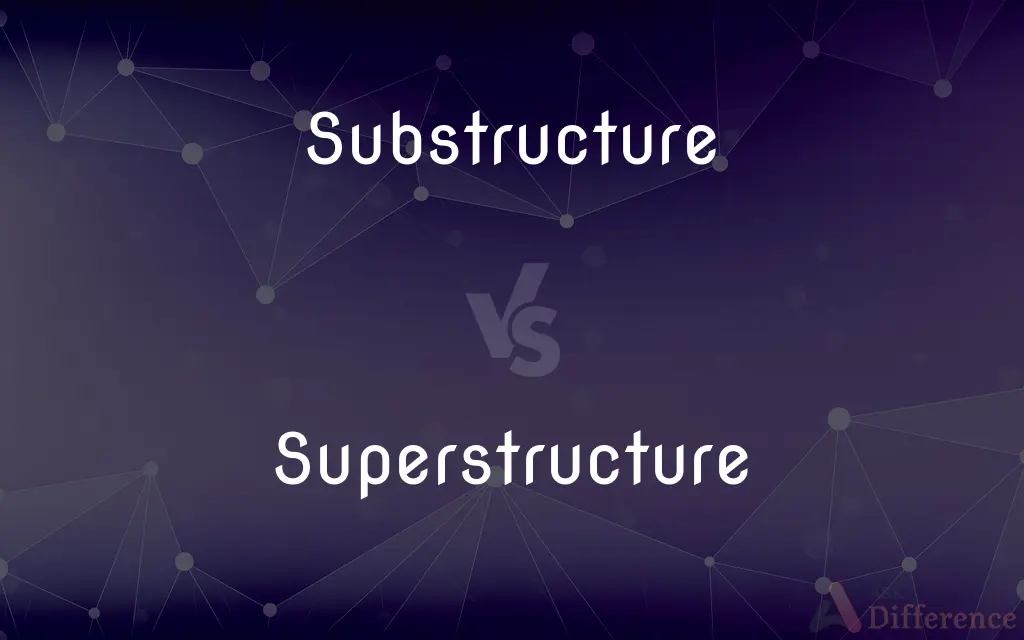Substructure vs. Superstructure — What's the Difference?
By Maham Liaqat & Fiza Rafique — Updated on March 27, 2024
Substructure is the underlying or supporting structure of a building, while superstructure is the part of a building above the foundation.

Difference Between Substructure and Superstructure
Table of Contents
ADVERTISEMENT
Key Differences
Substructure refers to the portion of a building's structure that is below ground level, serving as a foundation to support the superstructure. It includes components such as footings, basements, and piers that are crucial for distributing the building’s load to the ground. On the other hand, superstructure denotes the part of a building that is above ground level, encompassing elements like floors, walls, windows, and the roof, which define the building’s functional and aesthetic attributes.
The design and construction of the substructure are critical for ensuring the stability and durability of the building, focusing on strength, foundation depth, and resistance to soil moisture and movements. Whereas, the superstructure's construction considers factors like wind loads, seismic effects, and thermal performance to ensure safety, comfort, and energy efficiency.
Substructures are usually constructed from materials with high strength and resistance to decay and moisture, such as concrete and reinforced steel, due to their direct contact with the earth. Superstructures, however, may use a wider range of materials, including wood, steel, concrete, and glass, reflecting the architectural design and intended use of the building.
In terms of maintenance, the substructure requires attention to waterproofing, drainage, and foundation integrity to prevent structural issues. The superstructure’s maintenance involves addressing wear and tear on visible components, such as roofs, exterior walls, and windows, to preserve the building's appearance and functionality.
The engineering and architectural decisions for both substructure and superstructure are influenced by the building site’s geography, soil type, climate, and the building’s intended use, highlighting the interconnectedness of these two elements in overall building design and construction.
ADVERTISEMENT
Comparison Chart
Definition
The supporting structure below ground level.
The structure above ground level.
Components
Footings, basements, piers.
Floors, walls, roofs, windows.
Focus
Stability, foundation integrity.
Functional and aesthetic features.
Materials
Concrete, reinforced steel.
Wood, steel, concrete, glass.
Maintenance
Waterproofing, foundation checks.
Exterior repairs, thermal insulation.
Compare with Definitions
Substructure
Material Selection.
Waterproof concrete is used in substructures to prevent moisture damage.
Superstructure
Architectural Elements.
Architectural designs focus on the superstructure for aesthetic and functional purposes.
Substructure
Maintenance Needs.
Regular inspections ensure the substructure remains free of water infiltration and structural damage.
Superstructure
Diverse Materials.
Glass facades in superstructures allow for natural lighting and views.
Substructure
Underground Components.
Basements within the substructure offer additional living or storage space.
Superstructure
Construction Challenges.
Superstructure construction often involves crane operations to lift heavy materials.
Substructure
Foundation Support.
The substructure provides a stable base for the entire building, distributing its weight evenly.
Superstructure
Above-Ground Structure.
The superstructure defines the building’s height and shape, visible in the city’s skyline.
Substructure
Construction Focus.
The substructure’s construction prioritizes deep foundation systems in soft soil areas.
Superstructure
Energy Efficiency.
The superstructure’s design includes insulation and ventilation strategies for energy conservation.
Substructure
The supporting part of a structure; the foundation.
Superstructure
A superstructure is an upward extension of an existing structure above a baseline. This term is applied to various kinds of physical structures such as buildings, bridges, or ships having the degree of freedom zero (in the terms of theory of machines).
Substructure
The earth bank or bed supporting railroad tracks.
Superstructure
A physical or conceptual structure extended or developed from a basic form.
Substructure
The supporting part of a structure (either physical or organizational; the foundation).
Superstructure
The part of a building or other structure above the foundation.
Substructure
The earth or gravel that the railway tracks are embedded in.
Superstructure
The parts of a ship's structure above the main deck.
Substructure
(Marxism) base
Superstructure
The rails, sleepers, and other parts of a railway.
Substructure
Same as Substruction.
Superstructure
In Marxist theory, the ideologies or institutions of a society as distinct from the basic processes and direct social relations of material production and economics.
Substructure
An under structure; a foundation; groundwork.
Superstructure
(nautical) Any structure built above the top full deck (FM 55-501).
Substructure
The basic structure or features of a system or organization
Superstructure
Any material structure or edifice built on something else; that which is raised on a foundation or basis.
Substructure
Lowest support of a structure;
It was built on a base of solid rock
He stood at the foot of the tower
Superstructure
All that part of a building above the basement.
Superstructure
The sleepers and fastenings, in distinction from the roadbed.
Superstructure
(Marxism) The social sphere of ideology which includes religion, art, politics, law and all traditional values.
Superstructure
Any material structure or edifice built on something else; that which is raised on a foundation or basis
You have added to your natural endowments the superstructure of study.
Superstructure
The sleepers, and fastenings, in distinction from the roadbed.
Superstructure
Structure consisting of the part of a ship above the main deck
Common Curiosities
What is a substructure in construction?
A substructure is the part of a building’s structure located below ground level, providing foundational support.
Are there any special considerations for superstructure design in seismic areas?
Yes, in seismic areas, superstructures require design considerations for flexibility and strength to withstand earthquakes.
How are substructure and superstructure related?
They are complementary parts of a building's structure, where the substructure supports the superstructure, ensuring overall stability.
Can a building have multiple substructures?
Yes, especially in large or complex buildings, there can be multiple substructures to support different sections or features.
How does the design of the substructure affect the superstructure?
The design and integrity of the substructure directly impact the safety, durability, and feasibility of constructing the superstructure.
What role does the substructure play in waterproofing?
It includes systems and materials designed to prevent water ingress, protecting the building from moisture-related damage.
What is the impact of poor substructure maintenance?
Neglecting substructure maintenance can lead to serious structural issues, including foundation settlement and water damage.
What advancements are shaping superstructure construction?
Innovations like modular construction, green building materials, and smart technology are transforming superstructure construction.
What does superstructure mean in building terms?
Superstructure refers to the part of a building that is above ground level, including all structural and architectural components.
Can the superstructure be modified easily?
Modifications to the superstructure are possible but must consider the building's overall structural integrity and load distribution.
How does climate change affect substructure and superstructure planning?
Climate change introduces new challenges, requiring more resilient and adaptable designs to cope with extreme weather and rising sea levels.
Why is the substructure important?
It is crucial for distributing the building’s weight, ensuring stability, and preventing settlement or structural failure.
What materials are commonly used in superstructures?
Materials such as wood, steel, concrete, and glass are common, chosen based on the design and functionality of the building.
How do environmental conditions influence substructure design?
Soil type, water table, and climate can significantly affect substructure design, requiring tailored solutions for stability and durability.
Why is coordination between substructure and superstructure teams important?
Effective coordination ensures that both parts are seamlessly integrated, meeting design specifications and structural requirements.
Share Your Discovery

Previous Comparison
Ogre vs. Orc
Next Comparison
Gherkin vs. CornichonAuthor Spotlight
Written by
Maham LiaqatCo-written by
Fiza RafiqueFiza Rafique is a skilled content writer at AskDifference.com, where she meticulously refines and enhances written pieces. Drawing from her vast editorial expertise, Fiza ensures clarity, accuracy, and precision in every article. Passionate about language, she continually seeks to elevate the quality of content for readers worldwide.














































